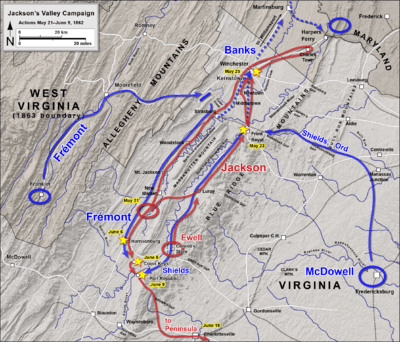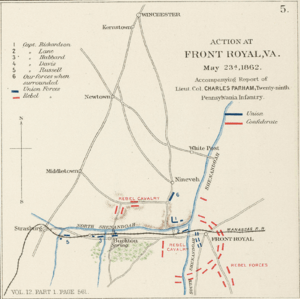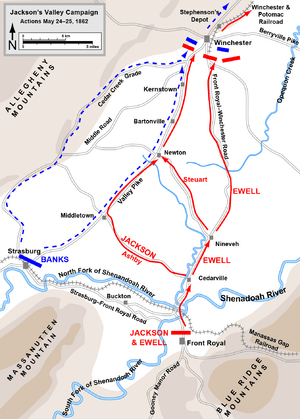Battle of Front Royal facts for kids
Quick facts for kids Battle of Front Royal |
|||||||
|---|---|---|---|---|---|---|---|
 The Union Army under Banks entering the town, by Edwin Forbes |
|||||||
|
|||||||
| Belligerents | |||||||
| Commanders and leaders | |||||||
| John Reese Kenly | Stonewall Jackson | ||||||
| Strength | |||||||
| 1,063 | 3,000 | ||||||
| Casualties and losses | |||||||
| 773 or 904 | 36 or 56 | ||||||
The Battle of Front Royal was a key fight during the American Civil War. It happened on May 23, 1862, in Warren County, Virginia. This battle was part of Jackson's Valley campaign, led by Confederate Major General Stonewall Jackson.
Jackson's main goal was to keep Union (Northern) forces busy in the Shenandoah Valley. This would stop them from joining another big Union attack called the Peninsula campaign. After winning a battle at McDowell, Virginia, Jackson turned his attention to Union forces led by Major General Nathaniel P. Banks.
Banks had most of his soldiers at Strasburg, Virginia. Smaller groups were in Winchester and Front Royal. Jackson launched a surprise attack on Front Royal. The Union defenders, led by Colonel John Reese Kenly, fought hard. They used cannons from Richardson's Hill to slow the Confederates down. But their escape route over the Shenandoah River was in danger.
The Union troops then pulled back across the river to Guard Hill. They tried to hold their ground there. However, Confederate soldiers soon crossed the river too. Kenly made one last stand at Cedarville. But a charge by 250 Confederate cavalry (soldiers on horseback) broke the Union lines. Many Union soldiers were captured. Jackson then continued his winning streak. He pushed Banks out of Winchester on May 25. He also won two more battles in June. Jackson's campaign kept about 60,000 Union soldiers from joining the Peninsula campaign. This allowed his men to join Robert E. Lee's Confederate army for the important Seven Days Battles.
Why the Battle Happened
In March 1862, the Union army, led by Major General George B. McClellan, started a big attack called the Peninsula campaign. This was on the Virginia Peninsula. At the same time, in the Shenandoah Valley to the west, Union Major General Nathaniel Banks pushed Confederate troops south. These Confederate troops were led by Stonewall Jackson.
Jackson had orders to keep Union soldiers busy in the Valley. This would prevent them from helping McClellan's campaign. By March 21, Union leaders thought Banks had too many soldiers in the Valley. So, many of them were sent to Washington, D.C.. Only about 9,000 of Banks's 35,000 men were left.
On March 23, Jackson attacked Union forces in the Valley. This was the First Battle of Kernstown. The Confederates were pushed back. But the attack worried Union leaders. They sent the rest of Banks's soldiers back to the Valley. They also kept another large group of soldiers near Manassas, Virginia. This meant about 60,000 Union soldiers could not join McClellan's campaign.
After Kernstown, Jackson moved south in the Valley. He joined forces with Major General Richard Ewell. Jackson left Ewell to face Banks. Then, Jackson took his troops southwest towards McDowell, Virginia. He went to fight a Union force led by Major General John C. Frémont. Part of Frémont's army attacked Jackson's men on May 8. This was the Battle of McDowell. The Confederates won, and Frémont's troops retreated. Jackson then moved his men back north to face Banks.
By this time, some of Banks's soldiers had been moved out of the Valley again. On May 12, a division of soldiers was ordered to move east. Banks then pulled his remaining troops back to Strasburg.
Jackson's Plan
Meanwhile, General Joseph E. Johnston ordered Ewell to take his soldiers to help Johnston's army. Jackson quickly asked Johnston to let Ewell stay with him. Jackson wanted to strike a blow against Banks. Jackson and Ewell decided Ewell would stay until Johnston replied. It took a few days for messages to travel. On May 20, Jackson received another order for Ewell to move east. Jackson then contacted General Robert E. Lee, an advisor to Confederate President Jefferson Davis. He asked to keep Ewell's men. Later that day, Johnston sent another message. This one gave Jackson permission to use Ewell's soldiers as he saw fit.
With Jackson and Ewell's forces combined, the Confederates had 17,000 men. They moved north again to attack Banks. The Union forces at Strasburg had built defenses facing south. But Jackson decided to move east instead. He planned to destroy the Union outpost at Front Royal. By taking Front Royal, Jackson could cut Banks's communication lines. He could then get behind the Strasburg position. This would force Banks to leave Strasburg or be captured. The Confederates began their march on May 21. They crossed Massanutten Mountain and entered the Page Valley to approach Front Royal. At this time, Banks had about 6,500 men in Strasburg, 1,000 in Front Royal, and 1,000 in Winchester.
The Battle Begins
Jackson prepared his attack on the morning of May 23. He sent Turner Ashby's cavalry (soldiers on horseback) between Front Royal and Strasburg. Their job was to cut telegraph lines and the railroad. This would stop Union forces from moving between the two towns. Jackson did not know how few Union soldiers were in Front Royal. So, he decided not to attack directly. Instead, Ewell's men would use the Gooney Manor Road for a surprise attack from the side. The Stonewall Brigade and some cannons stayed at Asbury's Chapel. This was about 4.5 miles (7.2 km) from Front Royal. Any Union soldiers retreating from Front Royal would have to cross two parts of the Shenandoah River.
Confederate soldiers captured some Union guards. They learned that the Union force in Front Royal was the 1st Maryland Infantry Regiment. So, Jackson ordered the Confederate 1st Maryland Infantry Regiment to lead the attack. This Confederate Maryland regiment had recently had some problems. But their commander, Colonel Bradley Tyler Johnson, gave a strong speech. This made the unit ready to fight.
Around 2:00 pm, the Confederate attack began. The Marylanders led the way. Behind them was Roberdeau Wheat's tough battalion of Louisiana Tigers. The rest of Brigadier General Richard Taylor's Louisiana soldiers were in reserve. A woman named Belle Boyd rode from the town. She gave Jackson information about the Union forces. However, historians say her role was not as important as some stories suggest. She told Jackson little he didn't already know.
The Union troops were completely surprised. They didn't know Confederate soldiers were so close. The Confederate attack quickly pushed the Union forces out of Front Royal and their camp. The Union commander, Colonel John Reese Kenly, pulled his remaining men back to Richardson's Hill. He set up two cannons there. Some of Kenly's men were captured in the town. A Union supply train was also taken.
In front of the new Union position was an open field. The Confederates would have to cross it to attack Kenly directly. The two Union cannons fired effectively at the Confederates. Jackson ordered his chief of artillery, Stapleton Crutchfield, to bring up cannons to fight back. But the first cannons brought up were too short-ranged. Crutchfield eventually found three cannons that could reach the Union position. A fifteen-minute cannon fight followed.
Kenly tried to make his line look stronger than it was. A small group of Union soldiers guarded the area between the two parts of the river. Some Union cavalry also arrived and attacked the Confederate scouts. Meanwhile, Johnson's Marylanders attacked the center. The 6th Louisiana Infantry Regiment attacked the Union left side. More of Taylor's men fought the Union right side. Some Confederate cavalry also raced for the bridge over the North Fork of the river. If they took the bridge, they would cut off the last Union escape route.
The arrival of the Confederate cavalry convinced Kenly to retreat around 4:30 pm. The Union troops pulled back across the bridges over both parts of the river. They then set the bridges on fire. The Confederates managed to put out the fires on the South Fork bridge. Jackson sent messengers to bring up the cannons and the Stonewall Brigade. These had been left behind earlier. But they were too far away to help in the fighting at Front Royal. Kenly reformed his soldiers on Guard Hill, across the North Fork. Many Confederates became disorganized and started taking things from the abandoned Union camp.
Around 6:00 pm, some Confederate cavalry managed to cross the river at a shallow spot. Part of the 8th Louisiana Infantry Regiment swam across. They were able to put out the fire on the North Fork bridge. Part of the bridge collapsed, but enough remained for men to cross one by one. With Confederates now across the river, Kenly's position on Guard Hill was no longer safe. He pulled his men back to the small town of Cedarville, Virginia.
Jackson ordered 250 cavalrymen to cross the burned bridge and chase the Union troops. Jackson himself followed them. Kenly made a stand at Cedarville. He set up his cannons and ordered the New York cavalry to charge. But the New York commander lost his courage and ordered his men to flee. The remaining Union troops formed a line at a house called Fairview. The Confederate cavalry charged this position twice. They were not stopped by Union gunfire. The Union line then broke into confusion. Kenly was wounded many times and captured. Most of the remaining Union soldiers were also captured.
While Jackson fought at Front Royal, Ashby's cavalry also met Union troops. Around 2:00 pm, his men attacked Buckton Station. This spot was defended by Union soldiers. An attack by 300 Confederates was pushed back. A second charge also did not go well. Ashby then pulled back along the railroad. He cut the railroad line and telegraph wires. This completed his goal of cutting off Front Royal from Banks. Historians describe this fighting as a "waste of lives."
What Happened Next
Historians say Jackson's losses at Front Royal were about 36 men killed and wounded. Kenly's Union force suffered about 773 casualties. Of these, 691 were taken prisoner. Other estimates say Union losses were 904, and Confederate losses were 56 or a little over 100. The Confederates also captured two cannons, many wagons, and about $300,000 worth of supplies. Ashby's mission also captured two trains.
Banks reacted to the fall of Front Royal by pulling his troops back from Strasburg to Winchester. Jackson attacked part of Banks's retreating force the next day. This was near Middletown. Then, Jackson defeated Banks in the First Battle of Winchester on May 25.
After winning at Winchester, Jackson moved his army towards Harpers Ferry. Meanwhile, Union Generals Frémont and Shields moved their forces towards Strasburg. They wanted to combine their armies against Jackson. Ashby, the Confederate cavalry leader, was killed in a small fight on June 6. Ewell was ordered to fight Frémont. He defeated Frémont's force at the Battle of Cross Keys on June 8. As Ewell's men left the field to rejoin Jackson, they burned a bridge. This stopped Frémont from joining forces with Shields. On June 9, Jackson defeated Shields in the Battle of Port Republic.
With Shields and Frémont retreating, Jackson was able to take his army from the Shenandoah Valley. They joined Lee's army for the Seven Days Battles. Jackson's Valley Campaign was a big success. It had kept many Union soldiers busy and prevented them from helping McClellan's main attack.




